Is onboarding still relevant in 2025, considering the economic and political shifts happening around the world? Some might think employees are reluctant to switch jobs in uncertain times, but the job market hasn’t hit pause. Hiring is still happening, and that means onboarding still matters. Actually, it matters more than ever, but we need to look closely at what the real employee onboarding trends for 2025 are to understand the context.
Replacing an employee remains an expensive effort. According to the Society for Human Resource Management (SHRM), many employers estimate the total cost of recruiting, hiring, and training a new employee can be three to four times the position’s salary. Forbes breaks that down to $225,000 to $300,000 for someone making $75,000 a year. With turnover rates still high and competition for talent staying strong, businesses can’t afford to lose good people.

That’s why, in 2025, onboarding should be seen as a long-term strategy, not a one-week checklist. It’s the key to driving engagement, productivity, and loyalty. In this article, we’ve grouped the employee onboarding trends for 2025 into two categories: human-centric experiences and tech-powered tools. Because in today’s world, it’s all about finding balance between the two.
Why Is Onboarding Important?
Employee onboarding is often an overlooked but critical component of organizational success. Surprisingly, according to Gallup’s research, only 12% of U.S. employees strongly agree that their organization does a great job onboarding new hires. Yet, the same Gallup research reveals that 70% of employees who experienced exceptional onboarding felt they had “the best possible job,” which is a clear indicator of how important the process is for employee satisfaction.
Effective onboarding:
- Drives employee engagement, retention, and productivity
- Helps reduce time to productivity
- Reinforces company culture and connection, especially in a fragmented workforce
- Builds long-term loyalty and reduces early turnover
For many businesses, investing in quality onboarding can be the key to retaining top talent and avoiding losses to competitors, not to mention preventing reputational damage. A poor first impression can go beyond the company itself, as new hires share their experiences with friends, colleagues and on sites like Glassdoor.
Top Human-Centric Employee Onboarding Trends for 2025
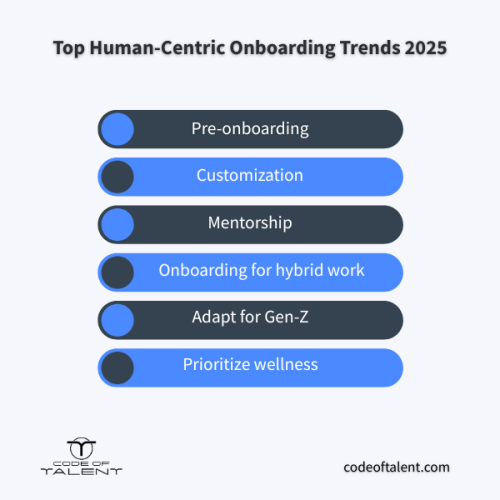
Here are some of the most influential employee onboarding trends in 2025, focusing solely on harnessing the connection between people and/or the organization.
1. Pre-Onboarding: Start the Connection Before Day One
Candidates backing out before they even start has been a long-time trend in modern hiring. Gartner research found that around 50% of selected candidates who accept job offers end up not showing up. This creates a lot of unnecessary delays and costs. Some of the reasons?
Why does this happen? Common reasons include:
- They received a better offer elsewhere
- Your offer was their backup while they waited on a preferred role
- Lack of communication from HR left them feeling disconnected
One way to combat this is through pre-boarding, where you start engaging candidates even before their first day. Pre-onboarding, which is a strategic onboarding procedure, could include:
- Sending welcome packages
- Sharing introductory videos
- Sending personalized messages from team leaders
- Providing clear information about what to expect on their first day
Such efforts not only increase excitement but also reduce first-day anxiety. Research shows a strong pre-boarding process can increase new hire retention by up to 82%, which helps reduce the number of non-starters.
2. Cohort-based Customized Onboarding
For a long time, onboarding followed a “one-size-fits-all” model, using standard processes that often overlooked the unique needs of different roles, departments, or individuals. But research in education shows that tailored learning experiences lead to higher motivation, better engagement, and improved retention. These same principles apply in the workplace.
That’s why many HR teams have shifted toward customized onboarding experiences. In smaller companies, this can be done on an individual basis. But in larger organizations or multinational companies, personalization typically happens at the cohort or team level, grouping new hires by function, location, or experience level to make onboarding and training more relevant.
Examples of cohort-based customization per industry:
- Healthcare Services
Role-specific simulations for clinical staff (e.g., patient check-in, triage procedures)
Compliance training grouped by clinical vs. administrative responsibilities - Telecommunications
Product knowledge training tailored to role (customer service vs. sales vs. technicians)
In-depth technical equipment training for field technicians
Scenario-based call simulations for customer-facing teams - Banking and Finance
Customer service and regulatory compliance training for frontline staff
Workflow and data handling sessions for back-office teams
Cross-functional onboarding for understanding operational processes - Pharma
Therapeutic area-specific product training for sales cohorts
Scientific communication training for medical reps
Presentation and relationship-building skills for sales reps - Retail
In-store scenario training for shop assistants
Training on handling complaints for customer service reps
Store-specific culture and operations orientation - Fast-Moving Consumer Goods (FMCG)
Route planning and merchandising training for field sales teams
Data analysis and retail strategy workshops for market developers
Regional product training tailored to local market conditions - Logistics and Courier Services
Vehicle safety and route optimization training for couriers and delivery drivers
Hands-on equipment and inventory handling sessions for warehouse staff
Compliance training for logistics teams - Call Centers
Product knowledge and customer interaction training for service agents
Troubleshooting protocol and system navigation workshops for technical support
Call simulation and performance metrics coaching for all roles
3. Mentorship
There’s no better way to learn than from others. It’s how we’ve learned since childhood, whether from parents, teachers, or more experienced people. In the workplace, mentorship plays a similar role. A mentor can be a manager, a colleague, or a dedicated orientation guide. They don’t just support new hires with job-related tasks, but also help with day-to-day things like understanding company culture, getting comfortable in the office, and meeting people across teams.
In 2025, mentorship is becoming even more important as companies shift back to on-site or hybrid work models. This is especially valuable for younger employees who may have started their careers remotely during the pandemic. In fact, 35% of companies are currently improving their mentoring programs as part of a strategy to build long-term talent.
Some benefits of mentorship include :
- Increases confidence and reduces feelings of isolation (according to Harvard Business Review research)
- Helping new hires adapt to company culture more quickly
- Improving knowledge retention and job performance
4. Onboarding for the Hybrid Work Model
Flexibility has become the buzzword of recent years, as more companies require employees to come back to the office at least 2-3 times per week, depending on their priorities. For example, office attendance has stabilized around 50% of pre-pandemic levels for the last two years. Still, policies vary widely: some companies have fully returned to in-person work, others have embraced hybrid setups, and some continue to operate remotely.
No matter the model, onboarding should adapt by blending virtual and in-person strategies. This can be done with:
- Asynchronous tools (tools you can use on your own time)
- Digital learning modules
- Virtual team-building activities
- Interactive and engaging learning technologies such as microlearning
- Mobile-friendly platforms
5. Gen Z: The New Workforce
According to the World Economic Forum, by 2025, Gen Z will make up 27% of the workforce in OECD countries. That means companies need to adapt their onboarding strategies to better meet the expectations of this new generation. Gen Z employees are known for setting clear personal and professional boundaries, which can lead to higher turnover if their needs aren’t met. In 2022, for example, Gen Z employees were changing jobs 134% more than in 2019.
Why are they leaving? Many are drawn to jobs that offer:
- Purpose-driven work
- Continuous learning opportunities
- Better pay
- Clear paths for career growth
What should onboarding include for Gen Z?
- Mentorship programs: To help them adapt to the office environment.
- A culture of feedback: They value opinions and are open to change.
- Inclusion and accountability: Gen Z is very vocal about social issues.
- Interactive learning: They have grown up with technology and short-form content, so they’re easily disengaged.
- Engaging methods like gamification: Turn training and onboarding into a game.
- Early interactions with managers: To help them become familiar with authority and responsibility.
6. Don’t Forget About Employees’ Wellness
Starting a new job can be overwhelming for a person, both physically and mentally. Add that to the expectation of being productive as soon as possible, the stress of learning new procedures, and adapting to a new environment, and you have the perfect recipe for burnout or mental health struggles.
That’s why employee well-being should be a priority when designing onboarding strategies. Here are a few ways to make onboarding less stressful:
- Allocate more time. Research suggests onboarding should span at least 1-3 months to give employees enough time to adjust to the culture, people, and expectations.
- Offer mental health resources. This could include therapy discounts, access to mental health apps, or coverage through the company’s insurance plan.
- Promote a safe and supportive environment. Encourage moral support from colleagues and set up Q&A sessions with HR.
- Balance learning with doing. Combine training time with practical exercises that slowly introduce new hires to their work.
- Include collaborative learning in training. People learn better together, whether from receiving or giving feedback.
Top Tech-Related Employee Onboarding Trends for 2025
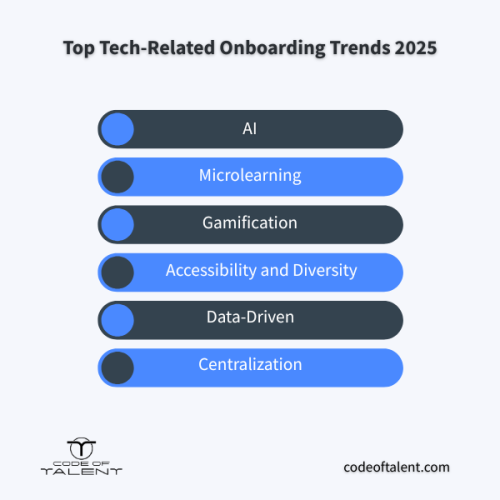
In 2025, ignoring the role of technology in onboarding is no longer an option. Besides automating tasks and streamlining work, technology brings people together, no matter their location. But it’s important to remember: technology should complement, not replace, the human experience.
1. Implement AI
AI has taken over the corporate world, including HR and training. Approximately 40% of jobs around the world will be affected by AI in the coming years, replacing some, but complementing others. In L&D particularly, AI will not replace professionals but will change the landscape.
According to trainingindustry.com, integrating AI into corporate training (including onboarding) leads to better learning outcomes and retention. A great example is Hitachi, which introduced an AI-powered digital assistant to support onboarding. As a result, onboarding time was reduced by four days.
Here are some features of AI that help in in onboarding:
- Personalization: Customizes learning paths based on role and experience level.
- AI chatbots and virtual assistants: Provides instant answers to FAQs, policies, and tech support, 24/7.
- Analytics: Tracks engagement and progress.
- Multilingual content delivery: Automatically translates materials in different languages.
- Automated assessments and feedback: Grades tasks and gives real-time, personalized feedback.
- Smart content curation: Breaks long training content into small modules.
2. Microlearning
As attention spans shrink, training methods have adapted to keep up. Microlearning has become a trend in recent years and an engaging solution to the pressing issues of content overload and low learning engagement. Microlearing breaks down learning into small missions (no longer than 7-10 minutes) with different types of engaging content: quizzes, videos, self-assessments, team-based activities, reflections, and role-playing exercises.
Microlearning is specifically effective because it revolves around simple principles:
- Delivers the right amount of information
- It can be accessed anytime, anywhere
- People learn in real time (aka on-the-job), as much as they want
- Puts theory into practice
3. Gamification
A new training trend has emerged in recent years. Heavily inspired by classic video games, gamification brings features such as leaderboards, points systems, badges, and medals, making learning engaging and fun.
The psychology behind it is simple: people are more motivated to complete their tasks if they know they’re competing for rewards. Major companies like Cisco and Microsoft have already embraced gamification and saw increased employee engagement.
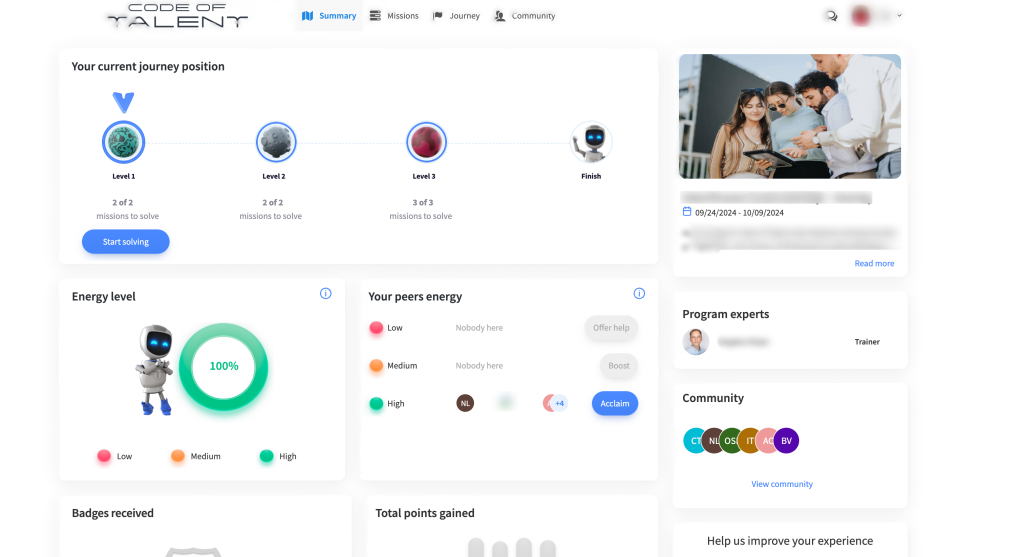
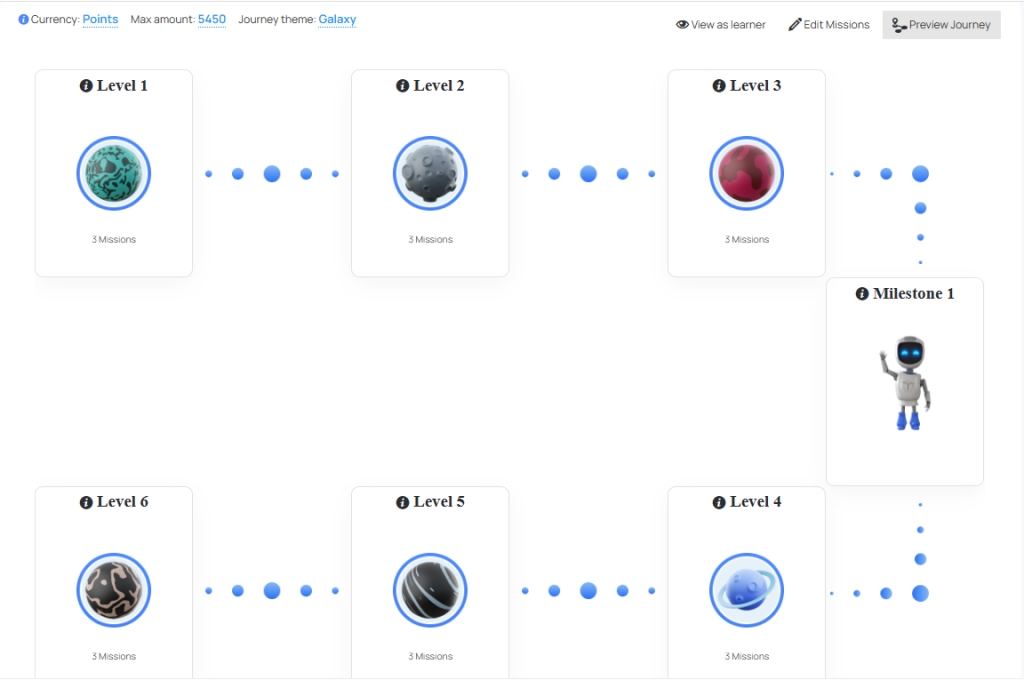
4. Accessible and Diverse Onboarding
Every new hire deserves to feel welcomed and supported from day one. That means thinking beyond the basics and making sure your onboarding program works for everyone, no matter their cultural background or any disabilities or health issues they might have. Some tactics might include:
- Offer content in multiple languages for non-native speakers and global teams
- Include captions and transcripts for all training videos for deaf and hard-of-hearing employees
- Use screen reader–friendly formats for visually impaired users
- Design training in short modules (microlearning) to support different or neurodiverse learning styles
- Provide a wide range of learning formats: videos, text, audio, and hands-on practice
- Use interactive tools like quizzes and polls to keep training engaging and participatory
- Schedule virtual and in-person options for onboarding sessions
5. Data-Driven Onboarding
Onboarding, much like training, has traditionally been hard to track. Engagement levels, learning retention, or even time to productivity aren’t always visible. Without measurable outcomes, it can be hard to demonstrate success. And in many organizations, executives speak in numbers. They want to see data-driven results that prove onboarding is a strategic investment.
Fortunately, many modern training and onboarding platforms come with built-in analytics and dashboards. They can track:
- Completion rates
- Time spent on each activity
- Knowledge check scores
- Feedback and satisfaction ratings
- Employee engagement over time
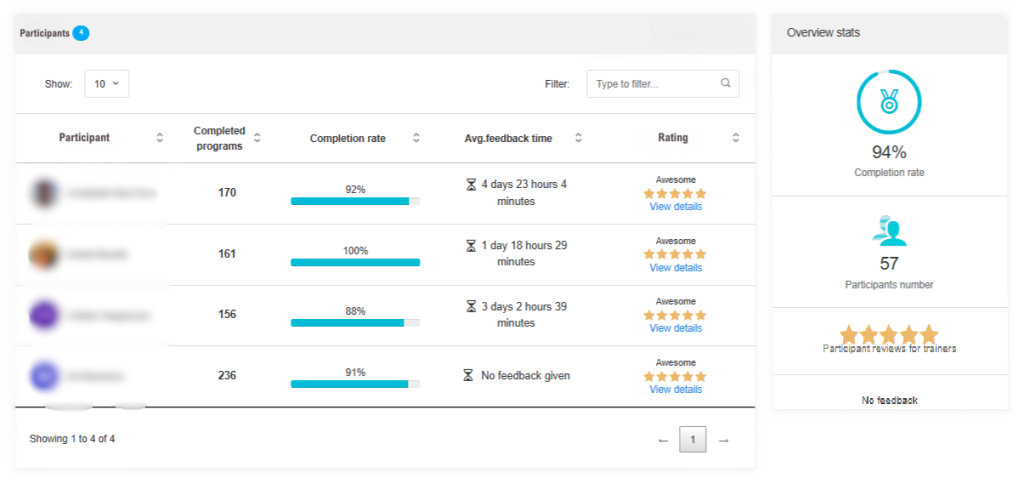
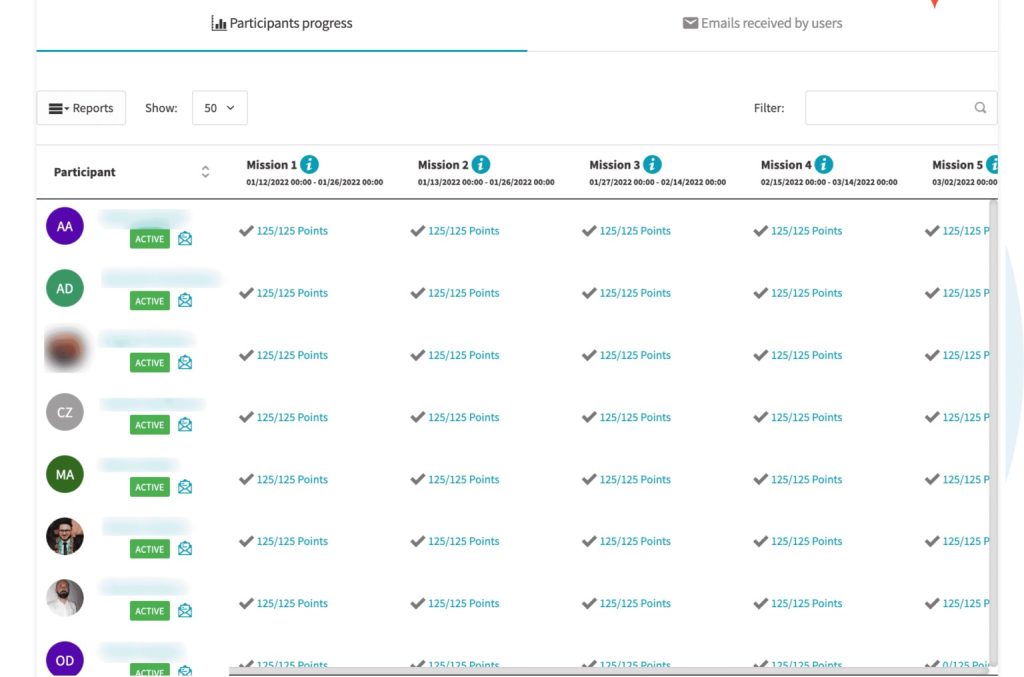
6. One Platform for All
We can’t talk about technology trends without mentioning tech fatigue. With so many available tools and platforms, it’s hard for both onboarding specialists and employees to keep up. In a recent survey, 42% of people claimed that they struggle to find what they need as their company’s information is scattered across too many platforms.
The best approach to combat tech fatigue is to simply choose a platform that integrates all (or at least most of) the features your company needs for onboarding. Centralization saves time and helps new hires focus on what really matters: learning and connecting.
Conclusion: Onboarding Is the New Strategic Advantage
As we move into 2025, employee onboarding is more than just an HR formality. It’s a strategic advantage that can drive engagement, retention, and long-term success. Whether it’s through personalized experiences, mentorship, integrating new generations, or implementing technologies like AI or microlearning, onboarding done right is essential for keeping your best talent.
Code of Talent‘s platform supports these trends by offering cutting-edge solutions that help you create an onboarding experience that is both efficient and relevant to today’s trends. Our platform offers:
- Cohort-based customized learning paths
- Gamification features
- AI integration, including an AI virtual assistant
- Feedback features from mentors, managers or L&D/HR professionals
- Data-driven insights, such as completion rates, feedback scores, and energy levels
- Mobile-friendly and accessibility features
- Engaging content, from interactive quizzes to real-life scenarios
- Collaborative learning with features such as team-based exercises or conversations between participants
- In-time learning, letting employees learn at their own pace.
Start your free trial today and experience how Code of Talent can help you put the top employee onboarding trends for 2025 into action — and stay ahead in the race for talent!





